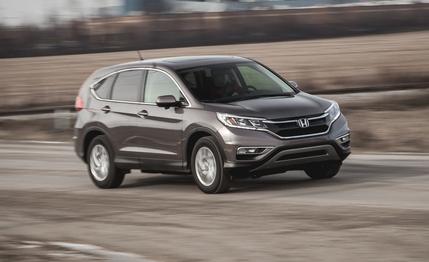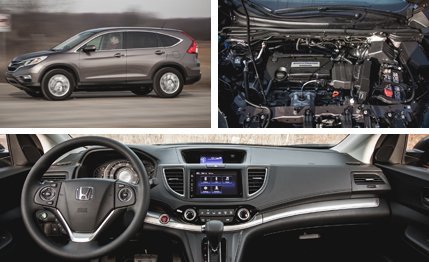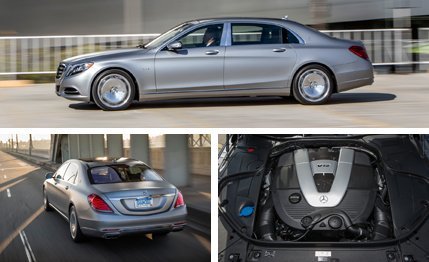
 Instrumented Test
Instrumented Test
Most automakers have pretty much moved on from producing Baja 1000–ready SUVs. It’s not that there isn’t still romance in the adventure of crashing over boulders at high speed and getting caked in the dust of desert competition. It’s just that modern car-based crossover SUVs like the Honda CR-V, with its elevated driving position; 70-plus cubic feet of cargo space (with the rear seats down); friendly fuel economy, ride, and handling; and available four-wheel drive, offer pretty much everything today’s buyer needs in such a vehicle.
Indeed, when the CR-V first broke cover in 1997 as a Civic-based high-roof wagon, Honda was rebadging Isuzu Rodeos as Passports and the number-one-selling SUV in the States was the truckulent body-on-frame Ford Explorer. But Americans, notoriously dismissive of hatchbacks, have embraced the SUV cum wagon cum crossover by the freeway load, and such vehicles are now the dominant, bestselling body style—better than compact sedans, mid-size sedans, and even pickup trucks. And at the top of that heap is the CR-V, which was the highest-selling crossover/SUV in the U.S. in 2014.
To help defend its market position, the 2015 CR-V received a minor visual freshening, having been updated with new sweeping projector-beam headlights and LED daytime running lamps outside and a slew of bright trim, upgraded materials, and electronics in the cabin.


Bigger changes came under the hood. The 2015 CR-V has the Accord’s direct-injected 185-hp “Earth Dreams” 2.4-liter four-cylinder and continuously variable automatic transmission. Although the new mill has no more power than last year’s port-injected four-holer of the same displacement, it reaches its power peak 600-rpm lower (now 6400) and it has more low-end torque (up from 163 to 181 lb-ft). The latter makes it feel livelier and more responsive than before. And the numbers back up that perception, with the 2015 front-drive EX version tested here moving off the dime considerably quicker than the 165-pound-heavier CR-V EX-L AWD we reviewed in 2012, reaching 60 mph 1.1 seconds quicker (7.5 seconds in the 2015 model) and clearing the quarter-mile traps 0.6 second ahead of the older model (15.9 seconds).
As CVTs go, Honda’s is one of the best, but it still will immediately swing the engine to its 6400-rpm power peak at wide-open throttle and stay there for the duration of the acceleration run. That’s what CVTs do in that situation, but in the ebb and flow of real traffic, when the 2.4-liter isn’t screaming to the finish line, the Honda CVT’s conventional-automatic-mimicking programming allows near instantaneous ratio changes without the pauses between shifts of a traditional step-gear transmission. As a result, the CR-V is never caught flat-footed in the wrong “gear.”
The new engine doesn’t need to rev quite as high to make peak power, but NVH takes a turn for the worse when the normally sweet-sounding engine rumbles along at a fuel-saving 1200 rpm cruising with light throttle. At that engine speed, the steering wheel, floor, and seat thrum slightly, as if the bass on a subwoofer got dialed up. The CR-V is otherwise one of the quietest-running crossovers in the compact class, but it would benefit greatly from a Honda Odyssey–like noise-cancellation system. Dropping the CVT into Sport mode raises revs and quells the rumble but doesn’t help fuel economy, which, by the way, was a somewhat disappointing 24 mpg—same as the 2012 AWD model—although it must be noted that we tend to drive harder than your typical CR-V owner.


Everything else is quite cheery. The CR-V’s generous front caster and rack-mounted electric power steering deliver a naturally weighted feel that’s never darty. The vehicle feels planted in its lane with decent self-centering and aligning torque for confident highway cruising, yet with an organic effort buildup as steering angle increases. The ride quality is everyday firm but never harsh over impacts. The CR-V’s front seats have good torso support, and the bottom cushions comfortably accommodate a variety of body shapes.
We think the $26,425 front-wheel-drive CR-V EX provides good value in the segment. Our test vehicle came standard with 17-inch aluminum wheels, a sunroof, fog lamps, a 10-way power driver’s seat, heated cloth front seats, proximity entry with push-button start, Honda LaneWatch (a passenger-side blind-spot camera), and a seven-inch touch-screen infotainment system. The single detraction from the infotainment’s user-friendliness is a thin row of tiny hard buttons that are difficult to see and hit while driving.
The EX is one of the CR-V’s more basic trims—and in that sense is truer to the crossover’s inner Civic than fancier versions. This particular model has no leather, no navigation, and certainly no semiautonomous systems to excuse inattentive driving. Never mind that the no-longer-wee CR-V SUV is really a hatchback on stilts—people like it, and so do we.